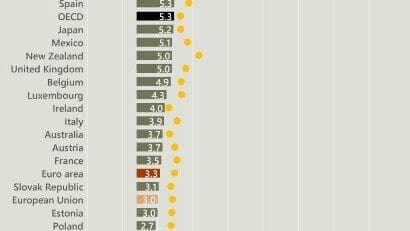Why are remittances still high in the Western Balkans?
Remittance flows for 2023 in Albania reached the amount of 929 million Euros, which have increased from last year by 95 million Euros more and are directed directly towards families for daily consumption, expenses for education, health, maintenance and travel. , as well as for savings and investments in real estate.
As it was stated in the Breaking show on Top Channel, it seems that remittances are the formal part of the money that enters the country alongside the informal money that circulates outside the banks.
Remittance flows[1] tend to be more stable than capital flows and they tend to be countercyclical, increasing during periods of economic downturn or after a natural disaster when private capital flows tend to decrease. In countries with a low level of domestic production, remittances are often a means of economic salvation mainly for the poor.
In the countries of the Western Balkans (WB6), according to World Bank data on the flow of remittances in % of the Domestic Product of each Balkan country, it turns out that Kosovo has the highest level of remittances, followed by Montenegro and Bosnia-Herzegovina. Albania holds the fourth place in the weight that remittances hold in relation to GDP, followed by Serbia at close levels. North Macedonia is the Balkan country that has a level of remittance inflows more than 3 times the average of the Balkan countries (see table). One of the reasons why we have this low level of remittances in Northern M. is also as a result of incomplete data[2] and influenced by informality.
| Remittances to the Western Balkans | % of GDP | |||||
| No. | Countries | Years | ||||
| 2018 | 2019 | 2020 | 2021 | 2022 | ||
| 1 | Albania | 9.6 | 9.6 | 9.7 | 9.6 | 9.2 |
| 2 | Bosnia-Herzegovina | 11 | 11.4 | 9.7 | 10 | 10.1 |
| 3 | Kosovo | 15.7 | 15.8 | 18.6 | 18 | 17.1 |
| 4 | Montenegro | 10.7 | 10.5 | 12.6 | 13.5 | 13.3 |
| 5 | North Macedonia | 3 | 2.8 | 3.8 | 3.5 | 3.4 |
| 6 | Serbia | 8.8 | 8.2 | 7.3 | 7.3 | 8.8 |
| 7 | Italia | 0.5 | ||||
| 8 | Greece | 0.2 | 0.3 | |||
Meanwhile, neighboring countries with WB6 seem to have remittances at negligible levels for their economies from immigrants, this fact being explained by their decrease depending on the years of immigration.
It seems that each country has its own specifics of emigration and migratory waves, which are mainly related to political and economic dynamics.
Countries that receive remittances from immigrants have impacts on economic dynamism, as immigrants by their nature are highly skilled and their departure creates a labor shortage.
However, for countries that have high levels of remittances from immigrants, they are affected by having an appreciation of the real exchange rate that can make the economy less competitive, but also the creation of a financial dependency, which negatively affects in the incentive to work and thus has a significant impact on economic growth from the decrease in production.
The strongest long-term effects of migration are population decline. The vast majority of immigrants are of young age and this tendency also affects the decline in births in the country, but with a consequence also in the aging of the population.
Although the missing policies and unproductive economic reforms are influential in increasing the supply to increase remittance flows and channel them into productive uses, this is precisely their most problematic part, as they influence the increase of cash in circulation. , but also keep the prices of products and services high due to a monetary supply in the market more than what is created by the country’s economy.
Tax incentives can attract remittances, but they can also encourage tax evasion.
In essence, remittances are private funds that should be treated as other sources of household income. Efforts to increase savings and improve the distribution of spending should be achieved through improvements in the overall investment climate and not by targeting remittances.
However, to date it appears that in WB6 countries inflows of remittances are being used as collateral to reduce international borrowing costs. Due to their size, countercyclical nature and indirect contribution to public finances, remittances with their increasing values in some of the BP6 countries are affecting the repayment capacity of the public debt, as they are a financial tool that some governments are using as source of internal borrowing, among others, from citizens.
The remittances of immigrants to WB6 countries will be at the same levels for many years, as they still have an impact on supplementing the missing income of their family members and will have a downward trend only if the effectiveness of economic reforms increases and political and if there is a visible advancement of their democracy.
[1] Remittances to the country where the migrant has family where part of their income in cash or goods is given to support their families and these transfers are known as migrant remittances.
[2] https://www.seeu.edu.mk/files/research/magchah-report-final.pdf, page 16




Leave a Reply
You must be logged in to post a comment.